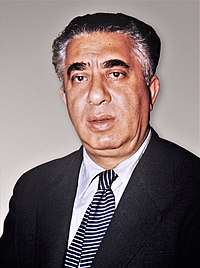Violin Concerto (Khachaturian)
Aram Khachaturian's Violin Concerto in D minor is a violin concerto in three movements composed in 1940. It was composed for David Oistrakh and was premiered on September 16, 1940 by Oistrakh.[1]
Composition
In 1940, Khachaturian was enjoying tremendous professional success and personal joy. [2] He worked on the concerto in the tranquility of a wood composer's retreat west of Moscow; he said of the composition that he "worked without effort ... Themes came to me in such abundance that I had a hard time putting them in order."[3] Many sections of the concerto are reminiscent of the folk music of Khachaturian's native Armenia—while he never directly quotes a specific folk melody, "the exotic Oriental flavor of Armenian scales and melodies and the captivating rhythmic diversity of dances" are throughout the work. [4] The work has been charactered by "an exhilarating rhythmic drive and vitality, and a penchant for intoxicating, highly flavored, languorous melody owning much to the inflections of his native Armenian folk music."[5] Having won the Stalin prize in 1941, it has since become one of Khachaturian's famous pieces, in spite of considerable criticism. [6]
Structure
Violin concerto in D minor (1940)
- First movement: Allegro con fermezza (about 14 minutes)
- Second movement: Andante sostenuto (about 12 minutes)
- Third movement: Allegro vivace (about 9 minutes)
A movement in sonata form, the Allegro con fermezza opens with a melody that has been described as "energetic"[7] a "rollicking dance-like theme,"[8] and this yields to a "more lyrical"[9] secondary melody.
The Andante sostenuto has been described as "a rhapsodic slow movement that sweeps one into a brooding wintry landscape." [10] Geoffrey Norris wrote, "The ease and spontaneity, pungency and flexibility of Khachaturian's melodic inventions are most clearly laid out in the Andante sostenuto of the central movement, cast in a free-flowing, quasi-improvisatory manner redolent of the art of Armenian folk music."[11] The second movement is a free-flowing rondo.[12]
The concluding Allegro vivace has been called "a whirlwind of motion and virtuosity."[13] In this movement, "the folks element is specially pronounced in the dance-like vigor of the main melody and in the repetitive, insistent, wild virtuosity of the solo instrument."[14]
Discography
References
- http://www.khachaturian.am/eng/konzert.htm
- Beaverton Symphony
- Khachaturian, Violin Concerto, EMI CDC 7 47087 2, CD liner notes by Geoffrey Norris
- Beaverton Symphony
- NAXOS Liner notes by Kevin Sutton
- https://worldmusicreport.com/reviews/cds/aram-khachaturian-violin-concerto-dimitri-shostakovich-string-quartets/
- Khachaturian, Violin Concerto, EMI CDC 7 47087 2, CD liner notes by Geoffrey Norris
- NAXOS Liner notes by Kevin Sutton
- NAXOS Liner notes by Kevin Sutton
- [http://www.musicweb-international.com/classrev/2004/may04/Khachaturian_Violin_concerto.htm NAXOS Liner notes by Kevin Sutton
- Khachaturian, Violin Concerto, EMI CDC 7 47087 2, CD liner notes by Geoffrey Norris
- http://www.kennedy-center.org/artist/composition/2082
- [http://www.musicweb-international.com/classrev/2004/may04/Khachaturian_Violin_concerto.htm NAXOS Liner notes by Kevin Sutton
- Khachaturian, Violin Concerto, EMI CDC 7 47087 2, CD liner notes by Geoffrey Norris
